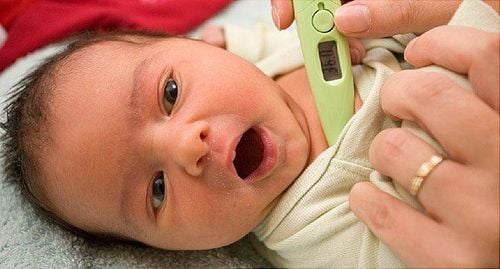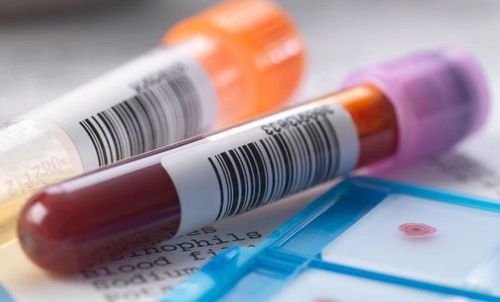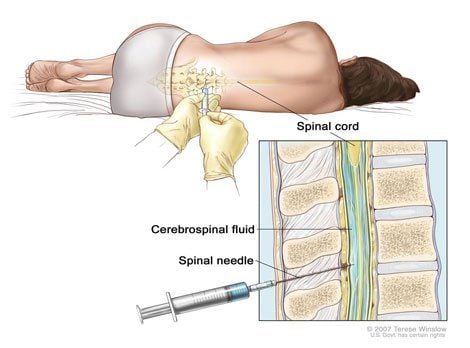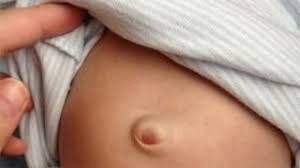This is an automatically translated article.
The article was consulted with Specialist Doctor I Dang Thi Ngoc Chuong - Department of Pediatrics - Neonatology, Vinmec Central Park International General Hospital.Neonatal meningitis is a rare but dangerous illness that can be life-threatening. It is very dangerous if a newborn baby with meningitis is not detected and treated properly early. Therefore, it is necessary to do some tests to diagnose neonatal meningitis such as total blood cell analysis, CRP, blood culture, blood sugar at the same time as lumbar puncture, brain ultrasound,...
1. Neonatal meningitis
Meningitis in infants is an inflammation of the thin membrane that covers the brain and spinal nerves. The main cause of meningitis is bacteria and viruses from elsewhere in the body through the bloodstream and into the cerebrospinal fluid. A few causes are caused by fungi, parasites or reactions to chemicals, autoimmune diseases...Neonatal meningitis is usually caused by three causes:
Meningitis purulent : Found in both children Neonates and older children Tuberculous meningitis: Common in children older than 2 years of age and usually occurs after a primary brain infection Lymphocytic meningitis: Occurs in both infants and older children Warning signs in children May have meningitis:
High fever with convulsions: As the most recognizable sign, the child may initially have only a mild fever and gradually turn the fever to an alarmingly high level. Many children with fever and convulsions are life-threatening if not treated immediately. Anorexia, vomiting: Children vomit, spit up due to full stomach distension, anorexia, stop eating, stop feeding, lazy to eat, fussy. Along with a fever, this is most likely a sign that the child has meningitis. To improve this situation, parents should try to divide meals for children, ensure the diet is full of nutrients and monitor children more Children are not alert, in a dream state: there are signs of more sleep normal, difficult to wake up, daydreaming, sometimes dreaming when awake. Parents will find that the child is less alert, listless, less sensitive, or irritable, the body movement will make the child feel pain, do not want to be held... Difficulty moving the neck area, stiff neck is a sign. characteristic of neonatal meningitis. The child has difficulty turning the head, pain when moving the neck. The fontanelle is larger than normal. The immune system is reduced, the resistance is weak, making the child weak and lifeless. There are signs of nosebleeds, bleeding gums, ear infections, choking occurring at the same time or just before the other symptoms mentioned above. Meningitis can leave sequelae such as:
Strabismus, mute, blind, deaf, water brain syndrome,... Focal nerve damage causing paralysis (maybe hemiplegia, paralysis of one limb, etc.) ..) Memory loss, dementia, mental disorders Epilepsy Therefore, in addition to clinical signs, it is necessary to do some tests to accurately diagnose neonatal meningitis.

2. Diagnostic tests for neonatal meningitis
2.1 Lumbar puncture The spinal tap is also called a lumbar puncture . Lumbar puncture is an important diagnostic test, and is performed when clinical examination suggests meningitis. In meningitis, when the central nervous system is damaged, the cerebrospinal fluid will also have corresponding changes. A lumbar puncture is a collection of spinal fluid that is then tested to determine the severity of the inflammation, the causative agent, and the susceptibility of the organism to the products. medicine. This is the most important technique in the diagnosis of neonatal meningitis.CSF is cloudy, Protein increases, glucose decreases by 1⁄2 Blood glucose, cells increase most of polymorphonuclear leukocytes and many cells degenerate and pus. Cerebrospinal fluid culture: Pathogenic bacteria may be found. However, in atypical cases, the cerebrospinal fluid may be clear, bloody or lemon-yellow... When the CSF is clear, it may still be mild early purulent meningitis (cerebrospinal fluid has not yet been detected). cloudy), but the most common is “headless” purulent meningitis (which is purulent meningitis that has been pre-emptively treated with antibiotics and is recovering). However, the differential diagnosis should be made from other clear water meningitis or meningoencephalitis. When the cerebrospinal fluid contains blood, it is possible that purulent meningitis with meningoencephalitis (usually meningococcal disease...), but needs to be differentiated from subarachnoid hemorrhage due to other causes or technical errors. during lumbar puncture. When the cerebrospinal fluid is lemon yellow: It can be purulent meningitis with hemorrhage, degenerating red blood cells or tuberculosis meningitis... 2.2 Blood tests Blood tests help assess the level of infection. In some cases, it may be necessary to culture blood and specimens at the site of infection to identify the causative agent.
Blood count considers the number and formula of white blood cells to help identify the group of pathogens, Procalcitonin, CRP .

2.4 Physical imaging tests (CT, MRI) Computed tomography and magnetic resonance imaging are used to diagnose complications of meningitis affecting the brain.
Normal craniogram, sinus scan and otoscope - mastoid to detect persistent elevation of intracranial pressure and also some risk factors for meningitis.
In addition, in special cases, it is possible to do more in-depth tests such as antigen - antibody determination, gene diffusion reaction, blood ion,...
In short, neonatal meningitis is The disease is not uncommon, can leave very serious sequelae and can be life-threatening to children. Therefore, when detecting abnormal signs, it is necessary for the child to go to medical facilities, to have the earliest diagnostic tests and timely intervention measures.
Pediatrics department at Vinmec International General Hospital is the address for receiving and examining diseases that infants and young children are susceptible to: viral fever, bacterial fever, otitis media, pneumonia in children, .... With modern equipment, sterile space, minimizing the impact as well as the risk of disease spread. Along with that is the dedication from the doctors with professional experience with pediatric patients, making the examination no longer a concern of the parents.
Please dial HOTLINE for more information or register for an appointment HERE. Download MyVinmec app to make appointments faster and to manage your bookings easily.














